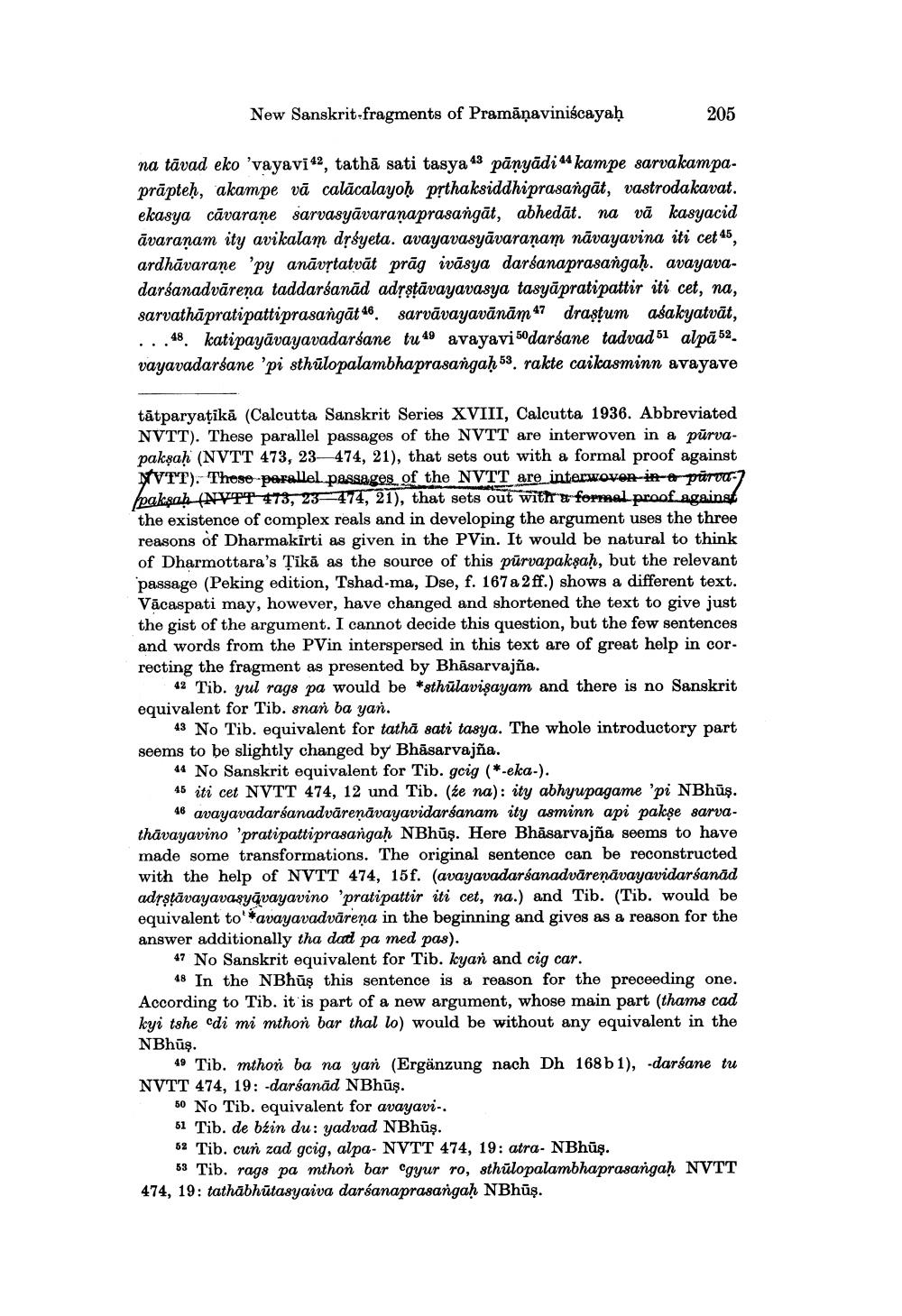________________
New Sanskrit fragments of Pramāņaviniscayaḥ
205
na tävad eko 'vayavi 42, tathā sati tasya 43 pānyādi 44 kampe sarvakampa. prāpteḥ, akampe vä сalācalayoḥ prthaksiddhiprasangät, vastrodakavat. ekasya cavarane sarvasyāvaranaprasangät, abhedāt. na vä kasyacid āvaranam ity avikalam dršyeta. avayavasyāvaranam nāvayavina iti cet 45, ardhāvarane 'py anāvrtatvāt prāg ivāsya darsanaprasangaḥ. avayavadarśanadvārena taddarsanād adsstāvayavasya tasyāpratipattir iti cet, na, sarvathāpratipattiprasangāt 46 sarvāvayavānām 47 draßtum asakyatvät, ...48 katipayāvayavadarśane tu 49 avayavi 50darśane tadvad 51 alpā 52. vayavadarsane 'pi sthūlopalambhaprasangah 53. rakte caikasminn avayave
nasarvo (*.lity abranno
tātparyaţikā (Calcutta Sanskrit Series XVIII, Calcutta 1936. Abbreviated NVTT). These parallel passages of the NVTT are interwoven in a pūrvapakṣaḥ (NVTT 473, 23474, 21), that sets out with a formal proof against MVTT). These parallel passages of the NVTT are interwovon-in-t pārvahpaksah (NVIT-473, 23474, 21), that sets out with a formal proof against the existence of complex reals and in developing the argument uses the three reasons of Dharmakirti as given in the PVin. It would be natural to think of Dharmottara's Tikā as the source of this pūrvapakṣaḥ, but the relevant passage (Peking edition, Tshad-ma, Dse, f. 167 a 2 ff.) shows a different text. Vācaspati may, however, have changed and shortened the text to give just the gist of the argument. I cannot decide this question, but the few sentences and words from the PVin interspersed in this text are of great help in correcting the fragment as presented by Bhāsarvajña.
42 Tib. yul rags pa would be *sthūlavişayam and there is no Sanskrit equivalent for Tib. snan ba yan.
43 No Tib. equivalent for tathā sati tasya. The whole introductory part seems to be slightly changed by Bhāsarvajña.
44 No Sanskrit equivalent for Tib. gcig (*-eka-). 45 iti cet NVTT 474, 12 und Tib. (ze na): ity abhyupagame 'pi NBhūş.
46 avayavadarśanadvāreņāvayavidarsanam ity asminn api pakse sarvathāvayavino 'pratipattiprasangaḥ NBhūş. Here Bhāsarvajña seems to have made some transformations. The original sentence can be reconstructed with the help of NVTT 474, 15f. (avayavadarśanadvāreņāvayavidarśanād adrştāvayavasyāvayavino 'pratipattir iti cet, na.) and Tib. (Tib. would be equivalent to'*avayavadvāreņa in the beginning and gives as a reason for the answer additionally tha dad pa med pas).
47 No Sanskrit equivalent for Tib. kyan and cig car.
48 In the NBhūş this sentence is a reason for the proceeding one. According to Tib. it is part of a new argument, whose main part (thams cad kyi tshe cdi mi mthon bar thal lo) would be without any equivalent in the NBhūş.
49 Tib. mthon ba na yan (Ergänzung nach Dh 168b 1), -darsane tu NVTT 474, 19: -darsanād NBhūş.
60 No Tib. equivalent for avayavi-. 51 Tib. de bzin du: yadvad NBhūş. 62 Tib. cun zad gcig, alpa- NVTT 474, 19: atra- NBhūş.
53 Tib. rags pa mthon bar Cgyur ro, sthūlopalambhaprasanga) NVTT 474, 19: tathābhūtasyaiva darśanaprasangaḥ NBhūş.




